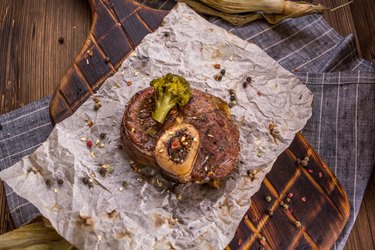
A thick slice of center-cut beef shank steak looks remarkably like a well-marbled steak and is often labeled as shank steak in retail stores. They're too tough for grilling, but like chuck steaks, they're ideal for braising.
The long, slow cooking process softens the tough muscle fibers and connective tissues, leaving the meat fork-tender with a luscious texture. The shanks also make their own sauce by infusing their cooking liquids with an intensely beefy flavor.
Video of the Day
Video of the Day
Making a beef shank recipe in a slow cooker or oven requires hours to cook, but only a few minutes of hands-on preparation. Regardless of your cooking method, cook your beef until the internal temperature is at least 145 degrees Fahrenheit — the minimum safe internal temperature for beef, according to the USDA Food Safety and Inspection Service.
Beef Shank Steak: Oven Method
Step 1: Preheat and Sear
Preheat your oven to 325 degrees Fahrenheit. Wipe the shank steaks with a clean paper towel to remove any bone fragments, then sear them one or two at a time in a hot skillet.
Step 2: Add Your Veggies
Transfer the shanks to a deep casserole dish or Dutch oven. Add coarsely chopped onions, carrots, celery, garlic, tomatoes or other aromatic ingredients as desired.
Step 3: Add Liquid and Bake
Pour in enough beef broth or other liquid to submerge the lower half of the shanks. Cover the casserole dish or Dutch oven, and slide it onto your oven's middle rack.
Step 4: Simmer Until Tender
Simmer the beef slowly in your oven until you can easily slide a fork into the shanks, and twist off a mouthful of tender beef with minimal effort. Depending how thickly your shank steaks were cut, this can take 2 1/2 to 4 hours.
Step 5: Remove Meat and Strain
Remove the shanks to a bowl or serving platter with a slotted spoon, then strain the cooking liquids into a narrow measuring cup.
Ladle off the fat that rises to the surface, then heat the juices in a saucepan and thicken them to make a sauce. Serve the sauce and shanks with your favorite side dishes.
Store leftovers at 40 degrees Fahrenheit and consume within three to four days. Discard any beef that has been at room temperature for more than two hours, as advised by the USDA.
Try the Slow Cooker Method
Step 1: Layer Veggies, Then Meat
Line the bottom of your slow cooker with a handful of coarsely chopped onions, garlic, carrots, celery or other aromatic ingredients as desired.
Sear your shank steaks in a hot skillet, and arrange them evenly on top of the vegetables.
Do not attempt to cook your beef from a frozen state in your slow cooker. This could delay the heating process and increase risk of foodborne illness, according to the University of Minnesota Extension.
Step 2: Add Cooking Liquid
Pour in 1 to 2 cups of beef broth or other cooking liquid. Your slow cooker will lose less moisture to evaporation, so it isn't necessary to use as much broth as you would in the oven.
Step 3: Cook (and Be Patient)
Cover the pot and plug it in. Cook the shanks for three to four hours on the high setting, or five to six hours on low. The shanks are ready when you can easily slide a fork into the tender meat.
Step 4: Remove Meat and Veggies
Transfer the shanks to a large bowl or serving platter with a slotted spoon, then strain the cooking juices to remove the aromatics. Ladle off any excess fat, then pour the liquids into a small saucepan and thicken them to make your sauce.
Step 5: Serve and Enjoy
Serve the sauce with your braised shanks and enjoy them with your choice of side dishes.
Read more: 10 Steak Recipes Any Carnivore Will Love
Try These Tips
Browning your beef shanks is an optional step, but it intensifies their rich, beefy flavor. Once cooked, the shanks can be shredded with a fork or your fingers and used as the filling in ravioli or other pasta. Alternatively, thicken the sauce and add cooked vegetables for a rich and hearty stew.
Although beef broth is the most natural choice of cooking liquids, there are many other alternatives. Tomato juice or tomato sauce, prepared beef gravy, barbecue sauce, red wine, dark beer and even water are all appropriate choices.
Other slow cooking techniques are also suitable for use with shanks. For example, the shanks could be baked at 275 degrees Fahrenheit for a similar length of time, without the use of a braising liquid. The key is to keep the meat at an internal temperature of 180 degrees Fahrenheit or higher for an extended period, so the tough connective tissues melt and form rich, moist gelatin.